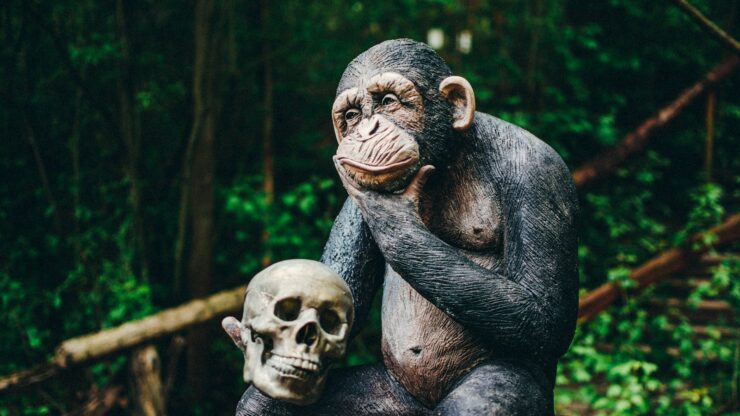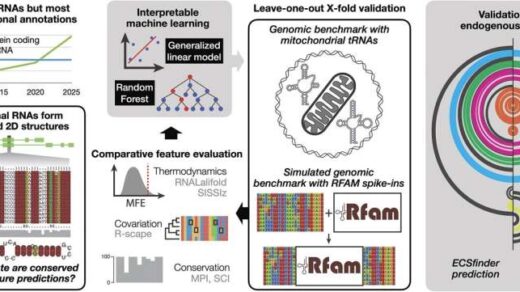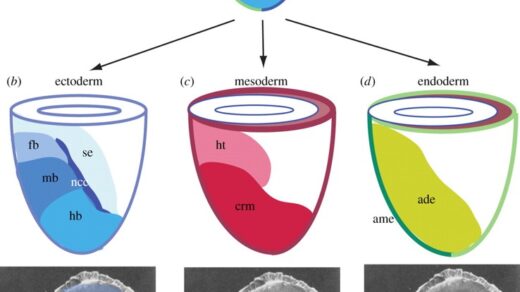For decades, scientists often claimed that humans and chimpanzees share nearly 99% of their DNA. This idea highlighted the close evolutionary link between our species. The figure implied only a 1% genetic gap, creating the widespread belief that we are almost identical to chimpanzees and bonobos.
Yet, modern advances in genomic sequencing reveal a more complex picture. Comparative studies show that the differences are far greater than once thought. Instead of a neat 1% variation, detailed analyses point to a wider genetic divergence. Recognizing this broader gap helps us better understand the evolutionary paths of humans and other primates.
How Was the “1% Difference” Between Humans and Chimps First Measured?
In 1975, Mary-Claire King and Allan Wilson reported a genetic divergence of about 1% between humans and chimpanzees. Their work shaped the early understanding of our close genetic relationship.
To measure sequence differences, researchers used techniques like the hydroxyapatite method, created by Dave Kohne and Roy J. Britten. This process involved pairing DNA strands from both species and then measuring the temperature at which the strands separated.
Several research groups applied this method and found about 1.76% divergence in single-copy DNA. These results gave rise to the widely quoted claim that humans share 98.5% of their DNA with chimpanzees.
Although groundbreaking, these methods had clear limits. They focused mainly on base substitutions in easily aligned regions and ignored many other genomic variations.
What Role Do Nucleotides and DNA Alignment Play in Measuring Human–Chimp Similarity?
At the core, both human and chimpanzee DNA rely on four basic units: adenine (A), guanine (G), cytosine (C), and thymine (T). Each genome stretches across about 3 billion letters, arranged in long sequences of these nucleotides.
When scientists compare the two genomes, they look for regions where sequences overlap. The number of matching letters in these sections becomes the foundation for calculating genetic similarity. David Haussler of the UC Santa Cruz Genomics Institute compares the task to reading a very long novel against a slightly edited version.
Early research suggested more than 98% similarity, implying that only 1 out of every 100 nucleotides differed. Today, scientists see this figure as misleading. Those early studies focused only on DNA regions that aligned easily. Hard-to-compare sections of the genome were often left out.
According to Tomas Marques-Bonet, head of Comparative Genomics at the Institute of Evolutionary Biology, as much as 15–20% of human DNA has no direct counterpart in chimpanzees. Ignoring these regions underestimated the true extent of divergence.
Why Are Insertions and Deletions (Indels) More Important Than Base Substitutions?
Modern sequencing technologies and computational tools show that human–chimpanzee DNA divergence is more complex than a simple percentage. In 2002, Roy J. Britten re-evaluated this difference by comparing five chimpanzee BAC sequences with matching human regions. His dataset included 779 kilobases of aligned DNA and accounted for insertions and deletions, not just base substitutions.
Britten found 1.4% divergence from substitutions and an additional 3.4% from indels. This raised the total difference to 5%, challenging the claim that humans share 98.5% of their DNA with chimpanzees. The 1.4% substitution rate was only slightly higher than earlier estimates of 1.25% and 1.23%. The increase came from including repeated sequences, which diverge faster than single-copy DNA, especially CpGs in Alu repeats that mutate at high rates.
His work showed that indels affect more nucleotides (3.4%) than substitutions (1.4%), a difference of over twofold. The sample contained about 1,000 indel events and 10,000 substitutions, yet the greater length of indels made them the stronger driver of divergence. Indels are stretches of DNA present in one genome but absent in the other, creating major evolutionary differences. Earlier studies often counted indels as single events, regardless of length, for convenience in phylogenetics. Britten argued that measuring the full length of these gaps gives a more accurate estimate. He also noted that gaps occur in both species in roughly equal amounts and appear in both repeated and non-repeated regions.
How Do Indels Form in Human and Chimpanzee Genomes?
The size distribution of indels offers important clues about their formation. Single-nucleotide gaps appear most often, and the frequency drops steadily as gap length increases. Larger indels also exist, with some spanning several kilobases, such as 4,263 nt, 3,545 nt, and 2,933 nt.
Several mechanisms explain how these indels form. One involves slippage in homopolymers, which are stretches of identical nucleotides. In one BAC studied, eight out of ten homopolymer regions longer than ten nucleotides contained gaps. This pattern suggests a high chance of slippage over the evolutionary distance between humans and chimpanzees.
Another mechanism is unequal crossover between repeat elements. Many long indels occur in regions with repeated DNA. For instance, a 4,263 nt gap missing in the human sequence of BAC AC007214 was made up mostly of L1 repeats in chimpanzees, along with a MaLR element. This points to unequal crossover between two L1 elements as a likely cause of large deletions, sometimes removing non-L1 regions as well. Other indels contained multiple Alu or SVA repeats, showing that events involving repetitive DNA are frequent drivers of insertions and deletions.
Not all indels involve known repeats. Some long gaps contain no recognizable repeats, or only low-complexity sequences, which suggests additional mechanisms are at work. Slippage in micro- and minisatellites also appears to contribute, as many of these regions differ in length between the two species.
How Do Genomic Rearrangements and Noncoding DNA Increase Human–Chimp Differences?
Large-scale genomic rearrangements and inversions also play a major role in human–chimpanzee divergence. For example, regions in the human genome similar to chimpanzee BAC AC006582 appear in two distant areas of human chromosome 12, separated by a clear break. This points to a rearrangement event in either lineage. Other cases involve BAC clones that cross known chromosome inversion sites between chimpanzee chromosome 10 and human chromosome 12. Duplication events also occurred, such as those seen in BAC AC007214, where stretches of DNA were copied. These findings suggest that rearrangements have been common throughout primate evolution.
The “one percent” view also ignored gene duplication and loss. Modern studies show that humans gained about 689 genes and lost 86 compared to chimpanzees, adding roughly 6.4% more divergence. Differences in genetic networks and chromosome structure make the picture even more complex and harder to measure with precision.
One of the most striking insights from comparative genomics is that most differences lie in noncoding DNA. This portion makes up about 98% of the genome and does not produce proteins. Instead, it holds regulatory regions that act like switches, controlling when and where genes are turned on or off. David Haussler notes that even small changes in these regions can strongly affect gene expression. These shifts can lead to major changes in phenotype, influencing traits such as body size or hair coverage.
In short, humans and chimpanzees share a similar “tool kit” of proteins, but they use these tools in different ways. Regulation, rather than the presence or absence of specific proteins, often explains the distinct features of each species. Katie Pollard describes it clearly: both species are made of the same building blocks, yet they are used in different ways to create a human versus a chimpanzee.
What Is the True Percentage of Genetic Difference Between Humans and Chimps?
When all factors are considered, the overall genetic divergence between humans and chimpanzees is far higher than the famous 1% claim. Roy J. Britten’s 2002 study estimated that 95% of base pairs match exactly, leaving a 5% difference once indels are included. Tomas Marques-Bonet argues that adding harder-to-align regions raises the difference to between 5% and 10%. He also notes that regions still too complex for current technology could push the true divergence above 10%.
A 2025 study reported by Live Science directly compared the two genomes and suggested a 15% difference. This approach also uncovered major variability, showing up to 9% divergence even within chimpanzee species. Such results highlight the complexity of full genomic comparisons.
Quantifying divergence with precision remains difficult. Britten admitted that his 779 kb sample was relatively small, and different BACs showed notable variation. Some large gaps may also have been missed because they could not be aligned with the human genome. Still, the evidence is clear: insertions and deletions are widespread, and they represent a major force in primate evolution.
Why Do These DNA Differences Matter for Evolutionary Research?
The recognition of indels as a major source of divergence carries important implications for evolutionary biology. Once a deletion occurs, the lost sequence is unlikely to be rebuilt unless it involves a repeat element that can be copied. This makes indels useful genetic markers for tracing evolutionary relationships among closely related species. By collecting and testing sets of indels, researchers could clarify the human–chimpanzee–gorilla trichotomy, although it is now widely accepted that chimpanzees and bonobos are our closest relatives.
Research also shows that divergence in some regions can exceed 20%. These areas often contain large gaps interrupted by distant similarities, pointing to complex evolutionary events. Repeated sequences and possible conversion processes likely shaped these regions, and they require further study to fully understand.
In summary, humans and chimpanzees remain genetically close, yet the claim of “99% similarity” oversimplifies the picture. Modern genomics reveals a deeper and more layered divergence by considering substitutions, insertions, deletions, rearrangements, and gene gain or loss. The most striking factor is the role of noncoding regulatory DNA. Even small changes in these regions can cascade through genetic networks, producing distinct traits and shaping species differences. This complexity underlines the dynamic and ongoing nature of primate genome evolution.
REFERENCES
Britten, R. J. (2002). Divergence between samples of chimpanzee and human DNA sequences is 5%, counting indels. Proceedings of the National Academy of Sciences of the United States of America, 99(21), 13633–13635. https://doi.org/10.1073/pnas.172510699


















